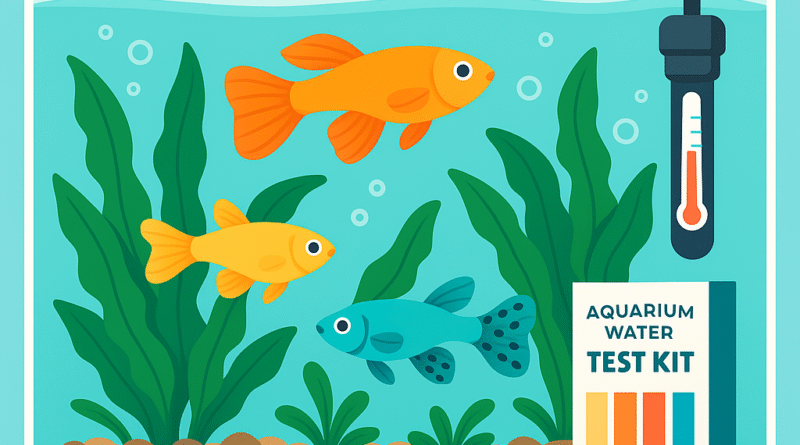The Beginner’s Guide to Avoiding Aquarium Mistakes
Introduction
Starting your first aquarium is an exciting journey — a chance to create a beautiful, thriving underwater world right in your own home. But like any new adventure, it’s easy to stumble into common pitfalls without even realising it.
Many beginners unknowingly make simple mistakes that can lead to stressed fish, cloudy water, algae outbreaks, or even full tank crashes. The good news? Most of these mistakes are easy to avoid once you know what to watch for.
In this beginner-friendly guide, we’ll break down the most frequent aquarium mistakes — from rushing the nitrogen cycle and overfeeding to mixing incompatible fish — and show you exactly how to prevent them. By learning from these common missteps, you’ll give your aquatic pets the healthy, balanced environment they deserve and enjoy a stress-free, rewarding aquarium experience.
Let’s dive in!
Mistake #1: Skipping the Nitrogen Cycle
One of the biggest and most damaging mistakes beginner aquarists make is adding fish before properly cycling their aquarium. The nitrogen cycle is a natural biological process that establishes beneficial bacteria, which convert toxic ammonia (produced by fish waste and uneaten food) into nitrites(harmful), and eventually into relatively safe nitrates.
Without a fully established nitrogen cycle, your tank becomes a toxic environment very quickly. Ammonia and nitrite spikes can stress fish, cause illness, burn gills, and lead to sudden deaths — often called “new tank syndrome.”
Real-World Example:
Imagine buying a group of small tetras for your first tank. You set up the aquarium, add tap water, decorate it nicely, and drop in the fish the same day. Within a few days, you notice the fish gasping at the surface, losing colour, or dying one by one. This tragic outcome happens because the nitrogen cycle was never completed — the tank couldn’t handle the waste they produced.
How to Avoid This Mistake:
- Set up your aquarium without any fish first.
- Add a small amount of fish food or bottled ammonia to “feed” the bacteria.
- Test your water every few days with a liquid test kit, monitoring for ammonia, nitrite, and nitrate changes.
- Be patient — a full cycle typically takes 4–6 weeks.
- Only add fish after ammonia and nitrite levels are 0 ppm and nitrates are starting to appear.
Starting your tank properly through the nitrogen cycle lays the foundation for a thriving, low-maintenance aquarium in the long run.
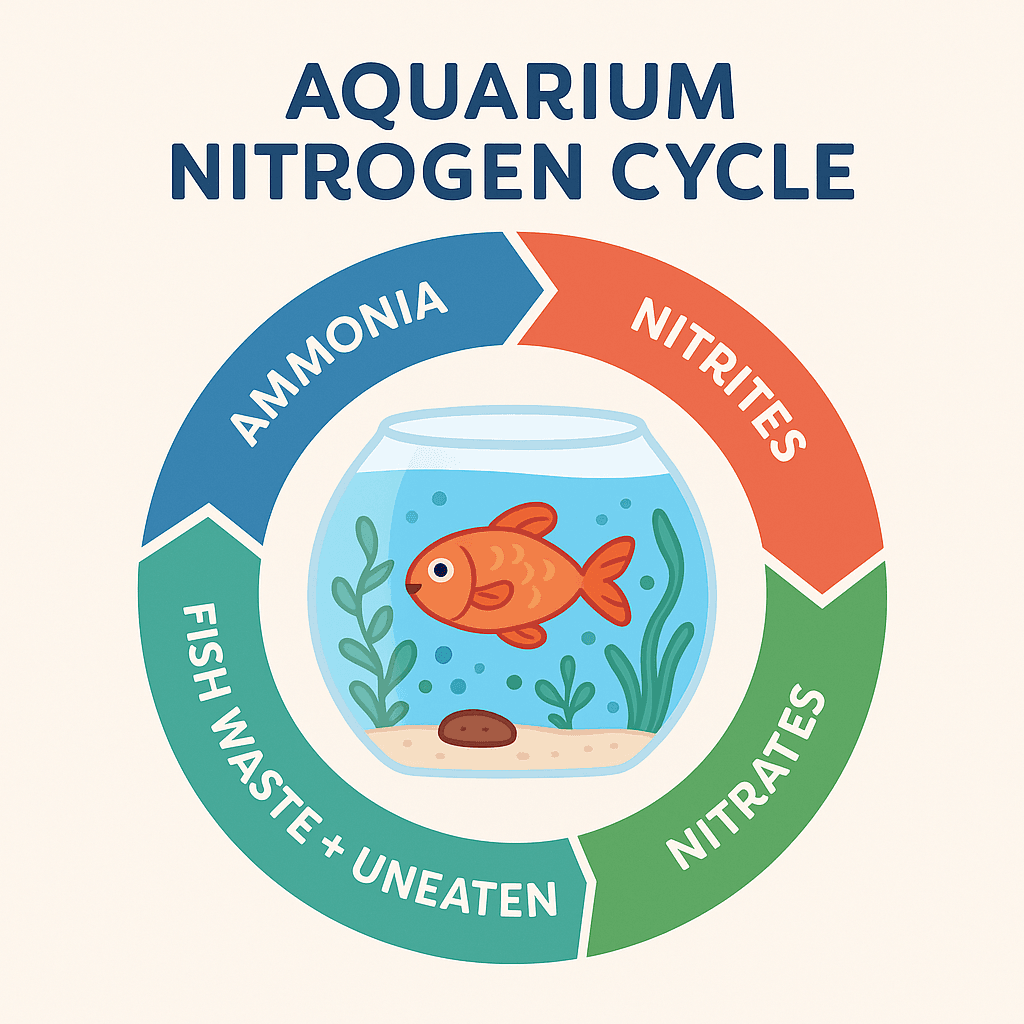
Mistake #2: Overstocking the Tank
It’s tempting to fill a new aquarium with colourful fish right away, but adding too many fish too quickly is a classic beginner mistake. Overstocking overwhelms your tank’s biological filter, causing ammonia and nitrite to rise faster than the bacteria can handle. The result? Stress, disease outbreaks, and potentially massive fish losses.
Real-World Example:
A beginner buys 10 neon tetras, 6 guppies, and 3 mollies for a 10-gallon tank — all in one trip to the pet store. Within a week, fish are struggling at the surface, there’s cloudy water, and disease sets in. The tank simply can’t biologically support that many fish at once.
How to Avoid This Mistake:
- Follow the general rule: 1 inch of adult fish per gallon (but adjust depending on species).
- Research the adult size of each fish, not the size when you buy them.
- Add fish slowly over weeks — this gives your biological filter time to adjust to the new bioload.
- Use a fish compatibility chart to plan your tank community wisely, ensuring peaceful species and manageable waste levels.
Pro Tip:
Always consider the overall activity level of your fish. Highly active species like danios or barbs need more swimming room than slow-moving species like bettas.
A carefully stocked tank stays cleaner, healthier, and creates a more natural, stress-free environment for your aquatic pets.
Need help selecting fish that won’t overcrowd your tank? This fish selection guide walks you through choosing compatible species, stocking density, and more.
If you’re considering shrimp, make sure you avoid common pitfalls by reading our beginner’s guide to freshwater shrimp care.
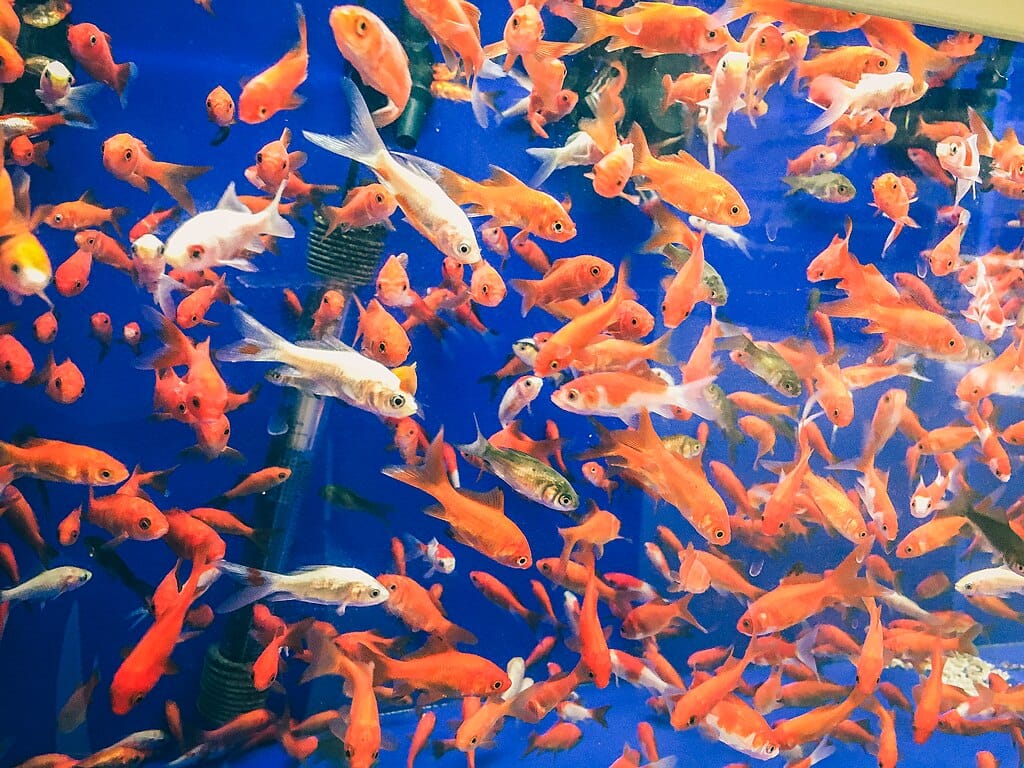
Mistake #3: Mixing Aggressive and Peaceful Fish
Choosing fish based solely on looks can cause big problems if you don’t consider temperament. Some species are naturally aggressive, territorial, or fin-nippers, while others are shy and peaceful. Mixing the wrong fish leads to bullying, stress, torn fins, hidden fish, and even fatalities.
Real-World Example:
A beginner adds a beautiful Betta fish to a tank full of fast-moving guppies and tetras. Within a few hours, the Betta is chasing and attacking anything that moves — and the stressed schooling fish hide constantly, ruining the look and feel of the tank.
How to Avoid This Mistake:
- Research each fish species carefully before buying.
- Look for temperament information: peaceful, semi-aggressive, aggressive.
- Use a fish compatibility chart when planning your community tank.
- Avoid combining known troublemakers (e.g., Cichlids, Bettas, Tiger Barbs) with peaceful or slow-moving species.
Pro Tip:
Always quarantine new fish before introducing them to an existing tank. Sometimes, aggression isn’t obvious in the store but flares up once territory is involved.
A peaceful tank is not only healthier but also far more enjoyable to watch, and your fish will display their best natural behaviours.
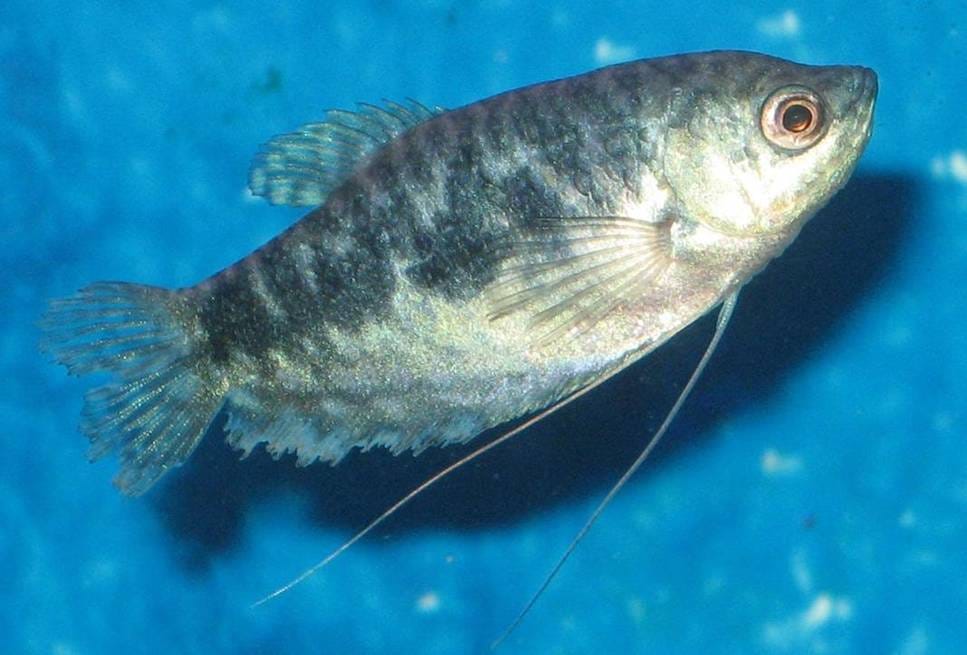
Mistake #4: Overfeeding Fish
Overfeeding is one of the most common — and most dangerous — mistakes beginners make. It’s easy to assume that if the fish are eating, they must be hungry. But fish will often eat out of instinct, not need, and excess food quickly fouls the water.
Rotting food releases ammonia, fueling harmful spikes and encouraging algae blooms. It can also lead to bloated fish, fatty liver disease, and even premature death.
Real-World Example:
A beginner feeds their fish three big meals a day, thinking they’re doing the right thing. After a few weeks, the water turns cloudy, snails or algae explode in the tank, and fish start showing signs of bloating and lethargy — all symptoms of overfeeding and poor water quality.
How to Avoid This Mistake:
- Feed your fish once or twice a day, only as much as they can eat in 2–3 minutes.
- Remove any uneaten food after feeding sessions.
- Remember that most healthy adult fish can easily fast for a day without harm, especially if you’re going away for a weekend.
- If in doubt, underfeed rather than overfeed — fish can survive far longer without food than with polluted water.
Pro Tip:
Schedule a “fasting day” once a week where you don’t feed your fish at all. It’s healthy for their digestive systems and helps control water quality.
Feeding the right amount creates a cleaner, healthier tank — and helps your fish live longer, more active lives.
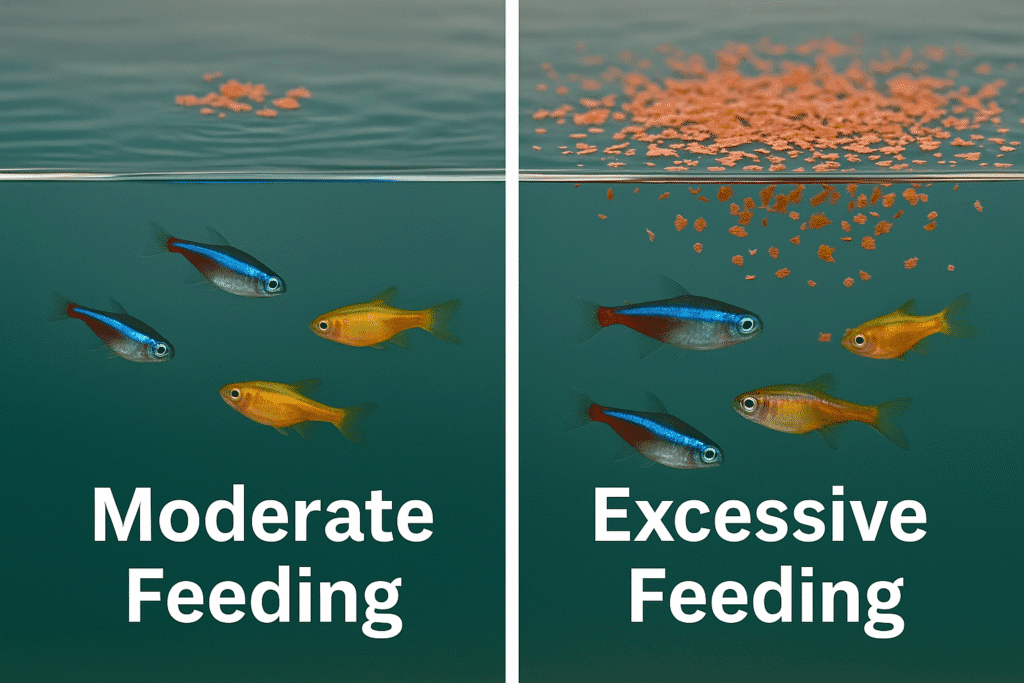
Mistake #5: Not Acclimating New Fish Properly
Introducing fish to a new tank is stressful for them — and if done too quickly, it can be fatal. Water parameters (temperature, pH, hardness) in your tank are likely very different from the conditions they experienced at the store. A sudden change can shock their system, weaken their immune response, and lead to death within hours or days.
Real-World Example:
A beginner buys a school of Corydoras catfish, floats the bag for five minutes, and dumps them straight into the tank. The next day, half the fish are listless or dead. The sudden difference in water chemistry overwhelmed their systems.
How to Avoid This Mistake:
- Float the bag containing the fish in your tank for 15–30 minutes to equalise temperature.
- Every 5 minutes, add a small amount of tank water into the bag (1/4 cup or so).
- After 30–45 minutes of gradual acclimation, gently net the fish out of the bag and release them into the tank.
(Do not pour bag water into your tank — it may contain contaminants.) - For sensitive species, consider drip acclimation using airline tubing for even slower adjustment.
Pro Tip:
Turn off your aquarium lights during and after acclimation. Dim lighting reduces stress and helps fish settle in calmly.
Taking a little extra time to acclimate fish properly greatly increases their chances of thriving in their new environment.
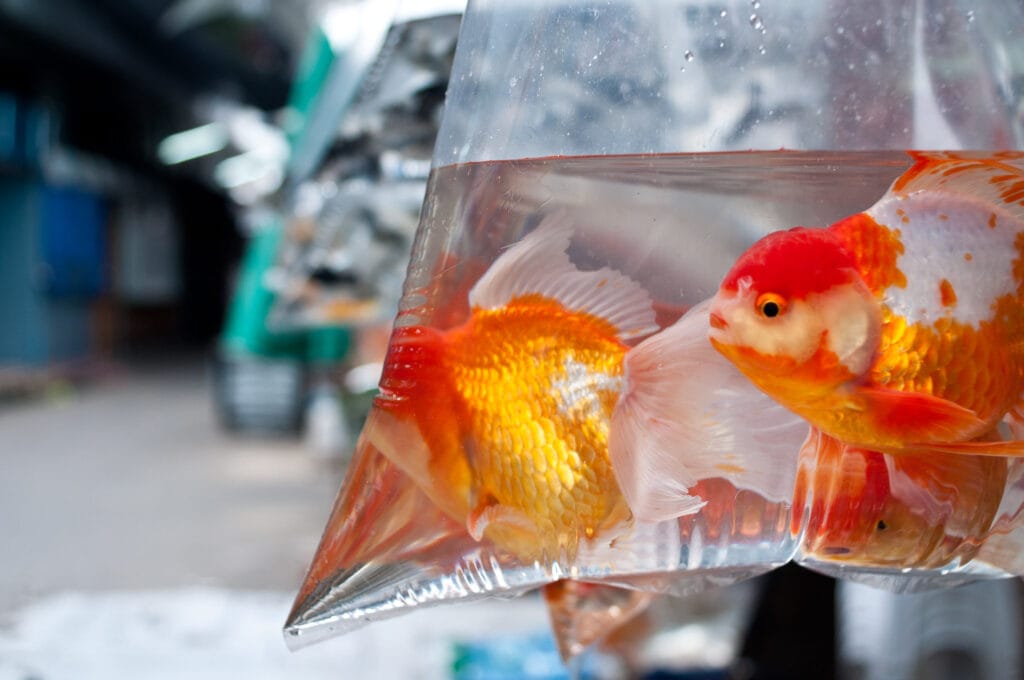
Mistake #6: Cleaning the Tank Too Aggressively or Infrequently
Both extremes — cleaning too much or not cleaning enough — can seriously harm your aquarium’s delicate balance.
Many beginners mistakenly scrub everything spotless during water changes, unknowingly destroying the beneficial bacteria colonies living on surfaces like gravel, decorations, and filter media.
On the flip side, infrequent maintenance allows waste to build up, leading to high ammonia, nitrate, and algae problems.
Real-World Example:
A beginner decides to deep-clean their tank by removing all fish, washing gravel with tap water, replacing all decorations, and rinsing the filter under the faucet. A few days later, fish start dying from an invisible ammonia spike — the tank’s biofilter was wiped out completely.
How to Avoid This Mistake:
- Perform regular partial water changes of 10–25% weekly or biweekly, depending on your stocking level.
- Use a gravel vacuum to gently remove debris from the substrate without disturbing too much beneficial bacteria.
- Wipe algae from the glass with an algae scraper — no chemicals needed.
- Rinse filter media only in tank water you remove during water changes, never under tap water, to preserve bacteria.
- Avoid replacing all filter media at once; stagger replacements if needed.
Pro Tip:
Track your water changes and cleaning tasks with a simple aquarium maintenance log — it keeps you consistent and reduces the chance of overdoing it.
A balanced cleaning routine keeps your tank stable, clear, and stress-free for your fish.
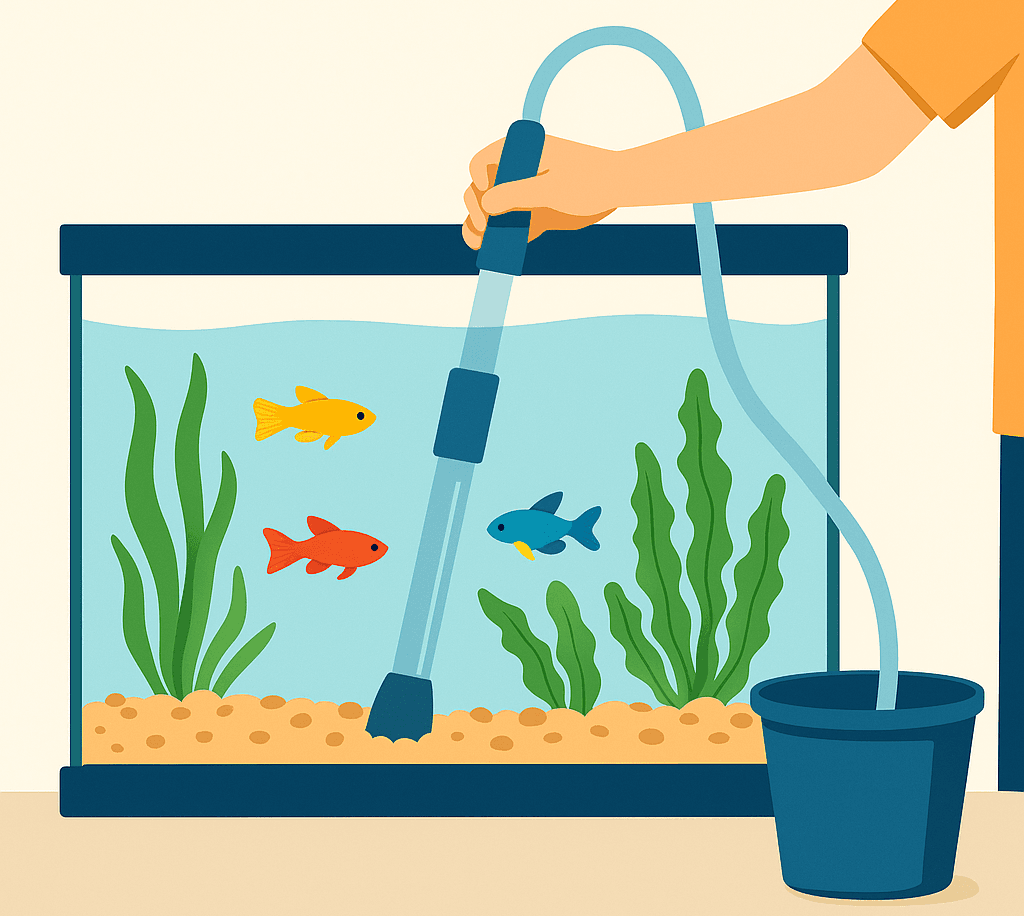
Mistake #7: Ignoring Water Testing
Many beginners make the mistake of judging their tank’s health based only on how it looks.
Clear water might seem clean, but it can still be full of invisible toxins like ammonia, nitrites, or excessive nitrates — all of which can harm or kill your fish over time.
Without regular water testing, small problems can snowball into major tank crashes seemingly overnight.
Real-World Example:
A beginner notices their fish are less active and losing colour, but since the water “looks fine,” they don’t investigate. Two days later, multiple fish are dead. Testing the water (only after the losses) reveals dangerously high nitrite levels that could have been corrected earlier with regular checks.
How to Avoid This Mistake:
- Test your tank water at least once a week, even if everything looks normal.
- Use a liquid test kit (like API Freshwater Master Kit) for more accurate readings compared to strips.
- Monitor key parameters:
- Ammonia: 0 ppm
- Nitrite: 0 ppm
- Nitrate: <40 ppm (preferably lower)
- pH: stable for your fish species
- Ammonia: 0 ppm
- Test after major changes (new fish, plant additions, water changes) to catch any issues early.
Pro Tip:
Keep a small notebook or a digital log of your test results. Tracking trends over time helps you catch slow water quality declines before they become emergencies.
Regular testing gives you real, actionable insights — helping your fish live longer, healthier lives.
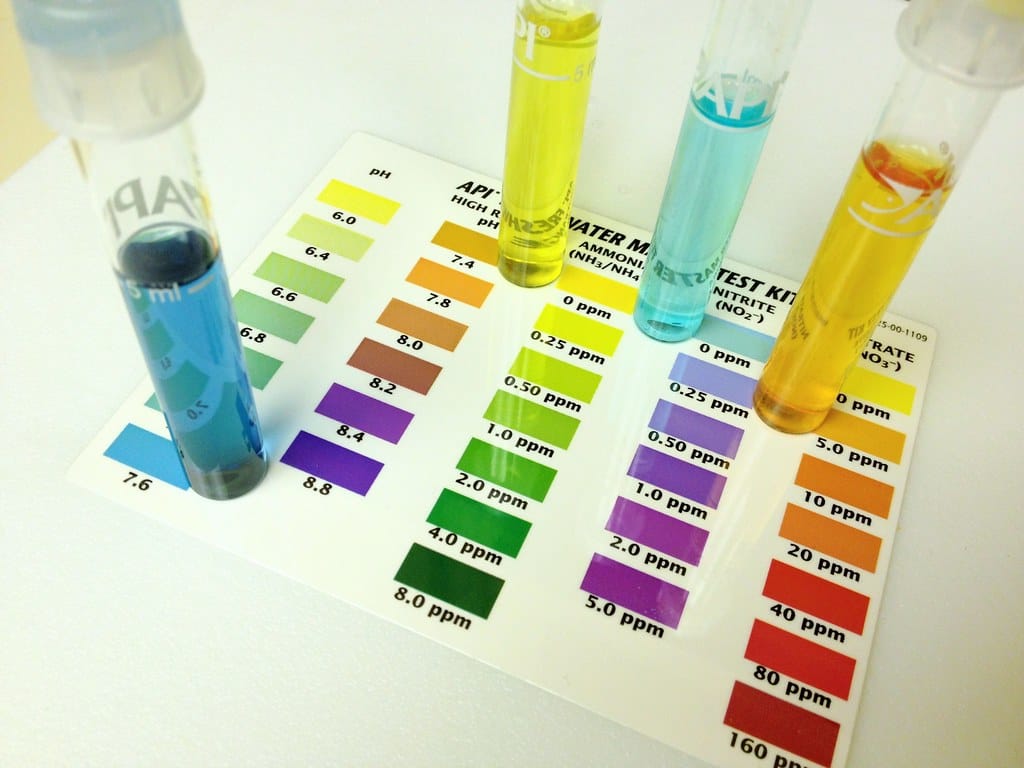
Mistake #8: Allowing Algae to Get Out of Control
A little algae is natural in every aquarium — it’s part of a balanced ecosystem.
But when algae grow unchecked, they block light, suffocate plants, clog filters, and can even deplete oxygen in the tank overnight.
Algae overgrowth is usually a sign of underlying issues like too much light, excess nutrients (from overfeeding or waste buildup), or unstable water parameters.
Real-World Example:
A beginner leaves the aquarium light on for 14 hours a day because they like seeing the tank brightly lit. Over the course of a month, green algae cover the glass, plants, rocks, and decorations. The tank looks cloudy and unhealthy, and fish activity drops.
How to Avoid This Mistake:
- Limit light exposure to 8–10 hours per day — use a timer if needed.
- Perform regular partial water changes to remove excess nutrients.
- Avoid overfeeding, as leftover food decomposes into algae fuel.
- Introduce algae-eating species like Amano shrimp, Otocinclus catfish, or Nerite snails as natural algae control helpers.
- Remove visible algae manually with algae scrapers or soft brushes during cleaning sessions.
Pro Tip:
Never use chemical algae killers unless it is absolutely necessary — they can harm your plants, fish, and beneficial bacteria. Mechanical removal and prevention are much safer and more sustainable.
By controlling algae naturally, you’ll enjoy a cleaner, more vibrant aquarium that’s healthier for both fish and plants.
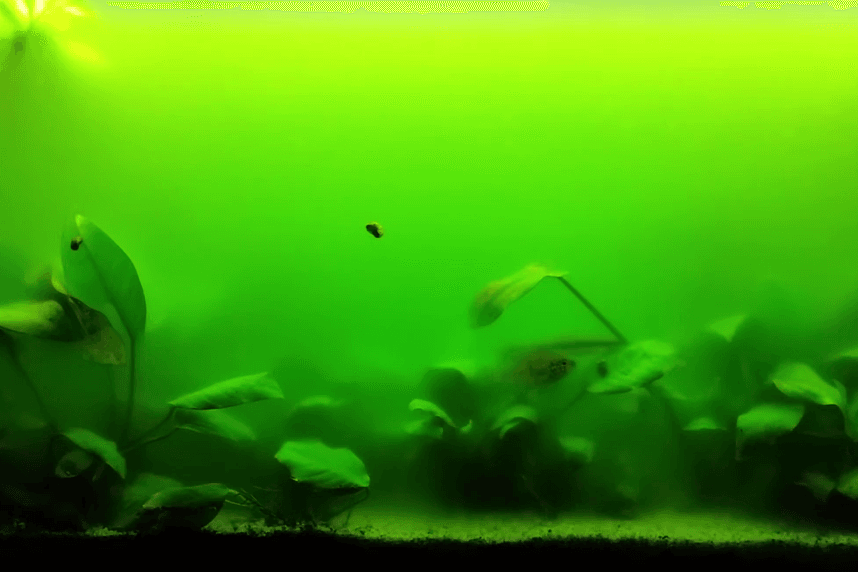
Bonus Tips for Beginners
Setting up your fish tank properly is important, but that is not the whole story. Successfully avoiding the most common mistakes sets you up for a thriving aquarium, but there are a few extra habits that can make your fishkeeping experience even easier and more rewarding:
1. Establish a Routine
Set a simple weekly schedule for feeding, water testing, and partial water changes. Consistency keeps your tank stable and prevents minor issues from becoming major problems.
2. Observe Your Fish Daily
Take a few minutes each day to watch your fish closely. Look for changes in behaviour, swimming patterns, appetite, or physical appearance. Early detection of problems like illness or aggression can save lives.
3. Start Slow and Add Fish Gradually
Even after cycling your tank, it’s important to introduce new fish slowly — just a few at a time. This allows your biofilter to adjust without overwhelming the system.
4. Research Before Buying
Before purchasing a new fish, plant, or piece of equipment, take five minutes to research it. Knowing the needs of your tank inhabitants and setup can prevent a lot of frustration later.
5. Keep Supplies Handy
Having essentials like water conditioners, test kits, a gravel vacuum, and extra filters on hand makes maintenance easier — and helps you react quickly if something unexpected happens.
Conclusion
Every aquarist starts somewhere, and making a few mistakes along the way is part of the learning process.
The key is understanding which common pitfalls to avoid early on, so you can enjoy a healthier, more stable aquarium from the beginning.
By cycling your tank properly, stocking wisely, maintaining a regular care routine, and paying close attention to your fish, you’ll create an environment where aquatic life can truly thrive.
Mistakes like overfeeding, ignoring water testing, or rushing acclimation are easy to prevent once you know what to watch for. Remember: patience, research, and observation are your greatest tools as a beginner fishkeeper.
Start slow, stay consistent, and enjoy the rewarding experience of building your own underwater world.

